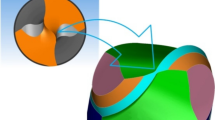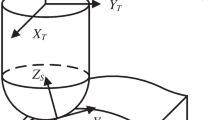Abstract
Having first defined the helical angle as the angle between the cutting edge and the axis of rotation of the cutter, this paper then presents design models for producing the cutting edge and groove of a ball-end cutter with concave-arc generator. The relative feed speeds of the grinding wheel in the radial and axial directions during NC machining of the cutter are derived based upon a given speed of rotation. The feed speed of the grinding wheel in the radial direction is modified according to the cross section of the groove that passes through the center of the cutter sphere. The paper presents a method for manufacturing a concave-arc ball-end (CABE) cutter using a 2-axis NC machine. The models that are used to calculate the actual obtained groove and the computer simulation method are also included. To further enhance the accuracy of the mathematical models, a compensatory machining process that eliminates residual profile on the revolving surface is presented. This paper provides a valuable reference for the design and machining of this cutter type.
Similar content being viewed by others
References
Barsov A (1978) Cutting tool production. Mir, Moscow, pp 179–184
Conell RS (1964) Tool and cutter grinding. Machinery Publishing, Brighton
Chen WF, Lai HY, Chen CK (2002) Design and NC machining of concave-arc ball-end milling cutters. Adv Manuf Technol 20(3):169–179
Chen WF, Lai HY, Chen CK (2001) A precision tool model for concave cone-end milling cutters. Adv Manuf Technol 18(8):567–578
Chen WF (2004a) A precision design for computer numerical machining models of involute-generator revolving cutters. Proc Inst Mech Eng B J Eng Manuf 218(5):517–531
Chen WF (2004b) A mathematical solution to the design and manufacturing problems of ball-end cutters having a cutting edge with constant angle to the axis. Proc Inst Mech Eng C J Mech Eng Sci 218(3):301–308
Lin PD, Lee MF (1997) NC data generation for 4-axis machine tools equipped with rotatory angle head attachments to produce variable pitch screws. Int J Mach Tools Manuf 37(3):341–353
Kaldor S, Rafael AM, Messinger D (1998) On the CAD of profiles for cutters and helical flutes-geometrical aspects. Ann CIRP 37(1):53–57
Sheth DS, Malkin S (1990) CAD/CAM for geometry and process analysis of helical groove machining. Ann CIRP 39(1):129–132
Yang MY, Park HD (1991) The prediction of cutting force in ball-end milling. Int J Mach Tool Manuf 31(1):45–54
Yucesan G, Altintas Y (1996) Prediction of ball-end milling forces. J Eng Ind 118(2):95–103
Tai CC, Fu KH (1995) Model for cutting forces prediction in ball-end milling. Int J Mach Tool Manuf 35(4):511–524
Lee P, and Altintas Y (1996) Prediction of ball-end milling forces from orthogonal cutting data. Int J Mach Tool Manuf 36(9):1059–1063
Gardon Y (1986) Mathematics and CAD: Numerical methods for CAD. MIT Press, Cambridge, MA
Liu HR (1995) The smooth conjunction of cutting edge ball-end milling cutter. Tool Eng 29(2):11–13
Chang-Xiu Z, Qian S, Min W (1995) Mathematical models for NC machining of special revolving cutter—the forming methods of the planar rake plane. J Southeast Univ 25(2):25–29
Zhou CX, Yue DQ, Wu XT (1991) The forming principle of special revolving cutter with planar rake plane. Tool Eng 25(5):17–21
Li LF (1995) Calculating the normal section of helical groove of the cutter by computer. Tool Eng (9):15–19
Kang DC, Xv X, Yao NX (1994) Calculating and measurement of cutting parameters of gear mill with helical groove. Tool Eng (5):15–20
Wu D (1977) Course for differential geometry. People Education Press, Beijing
Kaldor S, Rafael AM, Messinger D (1988) On the CAD of profiles for cutters and helical flutes-geometrical aspects. Ann CIRP 37(1):53–57
Author information
Authors and Affiliations
Corresponding author
Rights and permissions
About this article
Cite this article
Chen, CB., Wang, FS., Chang, PC. et al. A precision design and NC manufacturing model for concave-arc ball-end cutters. Int J Adv Manuf Technol 31, 283–296 (2006). https://doi.org/10.1007/s00170-005-0186-7
Received:
Accepted:
Published:
Issue Date:
DOI: https://doi.org/10.1007/s00170-005-0186-7




